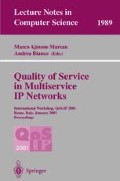Abstract
CSELT is evaluating the feasibility of provisioning Telephony over IP (ToIP) services. ToIP is different from Voice over IP, because it is intended as a Carrier-class service, fully featured and with quality of service guarantees, to be offered to a large number of users, either overlapping or substituting classical Plain Old Telephone Services. CSELT is performing both theoretical and experimental analysis; in particular we are focusing our work on the mechanisms and protocols developed in the standardisation bodies in order to verify how the telephony services can be supported by means of an IP network. In the first half of 2000 we have performed a laboratory trial in order to demonstrate the “proof-of-concept” of ToIP capabilities, performance and interoperability with TDM-based switching technology. In the solution tested in CSELT, provided by a leading manufacturer, the IP technology is deployed in the transit network, so it is necessary to have an interworking function between a traditional circuit network and the IP network. It must be underlined that the solution provided by the manufacturer, as requested by CSELT, was still at an early stage of development, hence it has not been possible to perform a full test campaign. From our theoretical analysis and laboratory experiment we observed the suitability of architectures proposed in the standardisation bodies and by the manufacturers for the provisioning of ToIP services. The experimented system, in particular considering its prototype nature, has shown high performance in terms both of voice and signalling quality. The main problem that arises in ToIP systems is the reliability of the system, that is a fundamental concept for providing carrier-class services. The detailed results of both the theoretical analysis and the laboratory experiment are presented in this paper.
Access this chapter
Tax calculation will be finalised at checkout
Purchases are for personal use only
Preview
Unable to display preview. Download preview PDF.
References
M. Hassan, A. Nayandoro, M. Atiquzzaman “Internet Telephony: Services, Technical Challenges and Products” IEEE Communication Magazine, April 2000, pp.96–103
B. Li, M. Hamdi, D. Jiang, Xi-Ren Cao, Y. T. Hou, “QoS-Enabled Voice Support in the Next-Generation Internet: Issues, Existing Approaches and Challenges” IEEE Communication Magazine, April 2000, pp. 54–61
IETF RFC 2719, “Framework Architecture for Signaling Transport”, October 1999
ITU-T, Recc. H.323v2 “Packet-based multimedia communications systems”, February 1998
ETSI DTS 02003 v0.10.3, “TIPHON Release 3; Network architecture and reference configurations”, May 2000
MSF, “MSF System Architecture Implementation Agreement”, December 1999
ETSI ETR NA003-“General aspects of QoS and Network Performance”, rev. 1994
ITU-T, Recc. G.131 “Control of talker echo”, agosto 1996
ITU-T, Recc. Q.709 “Specification of Signalling System No. 7.Hypothetical Signalling Reference Connection”, marzo 1993
ITU-T, Recc. Q.725 “Specification of Signalling System No. 7.Siganlling Performance in the Telephone Apllication”, marzo 1993
ITU-T, Recc. G.723 “Dual rate speech coder for multimedia communications transmitting at 5.3 and 6.3 kbit/s”, marzo 1996
ITU-T, Recc. G.729 “Coding of speech at 8 kbit/s using conjugate structure algebraic code excited linear prediction (CS-ACELP)”, marzo 1996
ITU-T, Recc. G.711 “Pulse Code Modulation (PCM) of voice frequencies”
ETSI DTR/Tiphon-05001 v1.2.5, “General aspects of QoS”, settembre 1998
IETF RFC 2205, “Resource ReSerVation Protocol (RSVP)-Version 1 Functional Specification”, settembre 1997.
IETF RFC 2475, “An Architecture for Differentiated Services”, dicembre 1998.
R. R. Stewart et al., “Simple Control Transmission Protocol-draft-ietf-sigtran-sctp-13”, July 2000
Author information
Authors and Affiliations
Editor information
Editors and Affiliations
Rights and permissions
Copyright information
© 2001 Springer-Verlag Berlin Heidelberg
About this paper
Cite this paper
De Luca, M., Senesi, P., Cuomo, F. (2001). Implementation of a Test-Bed for Telephony over IP: Architectural, Theoretical, and Performance Issues. In: Marsan, M.A., Bianco, A. (eds) Quality of Service in Multiservice IP Networks. QoS-IP 2001. Lecture Notes in Computer Science, vol 1989. Springer, Berlin, Heidelberg. https://doi.org/10.1007/3-540-44554-4_13
Download citation
DOI: https://doi.org/10.1007/3-540-44554-4_13
Published:
Publisher Name: Springer, Berlin, Heidelberg
Print ISBN: 978-3-540-41512-1
Online ISBN: 978-3-540-44554-8
eBook Packages: Springer Book Archive

